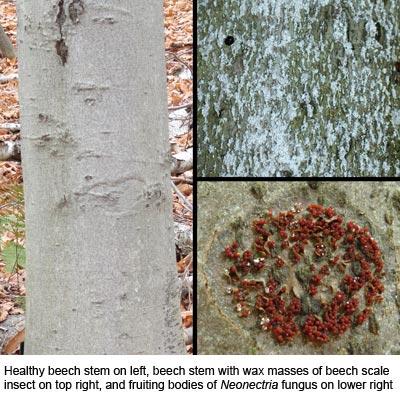An Alternative Model of Beech Bark Disease

Beech bark disease (BBD) has a long and destructive history affecting American beech trees in the northern hardwood forest. Historically, scientists believed that infestation by the beech scale insect (Cryptoccocus fagisuga) was the only necessary predisposing factor to infection by the causal fungi, Neonectria ditissima and N. faginata. Recent work in long-affected (aftermath) forests, however, suggests that other factors also drive disease development.
In New York state, NSRC researchers examined how bark nutrients, defensive chemicals, amino acids, and Xylococculus betulae, a native scale insect commonly found on beech, affect infection by these fungi. They also examined the potential role of these factors as drivers of beech scale populations. N. ditissima infection followed high X. betulae densities and low bark isorhamnetin concentration, while N. faginata infection followed high beech scale densities and low bark catechin concentration. Low bark phosphorus predisposed trees to both pathogens. Beech scale populations are driven by their density during the previous year but are associated with the phenolic 4-hydroxybenzoic acid, amino acids isoleucine and leucine, and bark boron.
Beech bark disease management in these forests should not focus solely on beech scale control and should instead focus on managing abiotic as well as biotic predisposing factors. The importance of low phosphorus to BBD development suggests increased prevalence of the disease in northeastern forests experiencing phosphorus-limitation following high nitrogen deposition from air pollution and acid rain.
